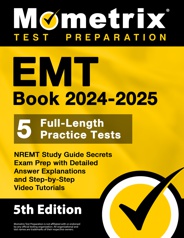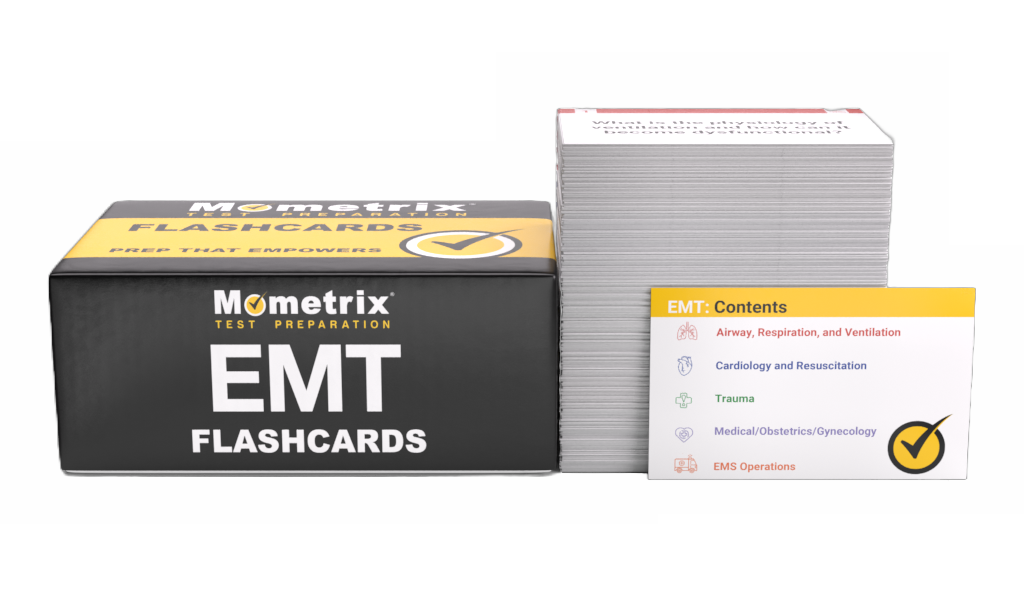To become a certified Emergency Medical Technician, you first need to complete the EMT cognitive exam. This is a knowledge-based test that measures your understanding of the fundamental principles and practices of working as an EMT.
Click “Start Test” above to take a free EMT practice test!
EMT Question of the Day
EMT Exam Eligibility
To be eligible for the EMT exam, you must meet all of the following requirements:
- You must have successfully completed a state-approved EMT course that meets NEMSES standards.
- You must have a current CPR-BLS for Healthcare Provider or similar credential.
- You must have successfully completed the National Registry cognitive exam and a state-approved psychomotor exam.
EMT Outline
The EMT exam contains between 70 and 120 multiple-choice questions, and you will be given 2 hours to complete it. Ten of the questions are unscored “pretest” questions. These questions are used to evaluate future exam questions’ fairness and validity.
This exam is a computer-adaptive test (CAT), so depending on your performance, the difficulty of your test will increase or decrease as you go on.
Here’s a look at how it works:
The first question is judged to be of medium difficulty, and depending on your performance, the next question may be easier or harder. If you do well on the first question, the second question will be harder; conversely, if you do poorly on the first question, the second question will be easy.
The exam is split into five content areas. For each of the first four areas, the questions are split between Adult (85%) and Pediatric (15%):
- Airway, Respiration, and Ventilation (18%-22%)
- Cardiology and Resuscitation (20%-24%)
- Trauma (14%-18%)
- Obstetrics and Gynecology (27%-31%)
- EMS Operations (10%-14%)
Questions will not appear in any particular order. The content areas will be mixed together and the actual balance of questions you see will depend on exactly how many questions you end up getting on the test.
Check out Mometrix's EMT Study Guide
Get practice questions, video tutorials, and detailed study lessons
Get Your Study Guide
Registration
Once you have met the requirements, you must send in an application along with the $98 application fee.
Once you have received your Authorization To Test (ATT), you have to schedule your exam for a date within the next 90 days. The exam is offered on a continuous basis and testing centers are located across the United States, so you will be able to choose a date and location that are most convenient for you. However, to ensure that there are still appointments available on your preferred date, make sure you schedule as soon as possible.
Test Day
You should arrive at the testing center at least 30 minutes prior to your scheduled exam time. Once you arrive, you will be asked to provide two forms of valid ID, one of which must be a photo ID, as well as any other documentation that may be required.
Before you entered the testing room, you will be asked to leave all personal items in a secured locker outside the room, though it is strongly encouraged that you leave these items in your car or at home. These include things like your cell phone, notebooks, pens, and bags.
Once you enter the testing room, you will be given a tutorial on how to take the exam, and you will be given a non-disclosure agreement (NDA) to read and sign. After the NDA has been signed, the exam will begin.
How the Exam is Scored
Because the EMT exam is computer-adaptive, there is no set passing score.
If you are consistently answering questions correctly and keeping your average score above a certain threshold, the computer will stop the exam and notify you that you have passed. If, however, you are consistently answering questions incorrectly and staying below a certain threshold, the test will stop and you will be notified that you did not pass.
EMT Online Prep Course
If you want to be fully prepared, Mometrix offers an online EMT prep course designed to give you everything you need to succeed!
Here’s what you’ll find in the EMT course:
- 70+ Review Lessons Covering Every Topic
- Over 700 EMT Practice Questions
- 30+ Video Tutorials
- 550+ Digital Flashcards
- Money-back Guarantee
- Mobile Access
Everyone learns differently, so we’ve tailored the EMT online prep course to ensure every learner has what they need to prepare for the EMT exam.
Click below to check it out!

Check out Mometrix's EMT Flashcards
Get complex subjects broken down into easily understandable concepts
Get Your Flashcards
Study Tips
How to Study Effectively
Your success on EMT test day depends not only on how many hours you put into preparing but also on whether you prepared the right way. It’s good to check along the way to see whether your studying is paying off. One of the most effective ways to do this is by taking EMT practice tests to evaluate your progress. Practice tests are useful because they show exactly where you need to improve. Every time you take a free EMT exam practice test, pay special attention to these three groups of questions:
- The questions you got wrong
- The ones you had to guess on, even if you guessed right
- The ones you found difficult or slow to work through
This will show you exactly what your weak areas are and where you need to devote more study time. Ask yourself why each of these questions gave you trouble. Was it because you didn’t understand the material? Was it because you didn’t remember the vocabulary? Do you need more repetitions on this type of question to build speed and confidence? Dig into those questions and figure out how you can strengthen your weak areas as you go back to review the material.
Answer Explanations
Additionally, many EMT practice tests have a section explaining the answer choices. It can be tempting to read the explanation and think that you now have a good understanding of the concept. However, an explanation likely only covers part of the question’s broader context. Even if the explanation makes sense, go back and investigate every concept related to the question until you’re positive you have a thorough understanding.
Comprehend Each Topic
As you go along, keep in mind that the EMT practice test is just that: practice. Memorizing these questions and answers will not be very helpful on the actual test because it is unlikely to have any of the same exact questions. If you only know the right answers to the sample questions, you won’t be prepared for the real thing. Study the concepts until you understand them fully, and then you’ll be able to answer any question that shows up on the test.
Strategy for EMT Practice
When you’re ready to start taking practice tests, follow this strategy:
- Remove Limitations. Take the first test with no time constraints and with your notes and EMT study guide handy. Take your time and focus on applying the strategies you’ve learned.
- Time Yourself. Take the second practice test “open book” as well, but set a timer and practice pacing yourself to finish in time.
- Simulate Test Day. Take any other practice tests as if it were test day. Set a timer and put away your study materials. Sit at a table or desk in a quiet room, imagine yourself at the testing center, and answer questions as quickly and accurately as possible.
- Keep Practicing. Keep taking practice tests on a regular basis until you run out of practice tests or it’s time for the actual test. Your mind will be ready for the schedule and stress of test day, and you’ll be able to focus on recalling the material you’ve learned.
FAQs
Q
How many questions are on the EMT exam?
A
There are 70-120 questions on the exam. The number of questions you answer overall depends on how well you answer each one.
Q
How long is the EMT exam?
A
The time limit for this exam is 2 hours.
Q
How much does the EMT exam cost?
A
The fee for this exam is $98.



